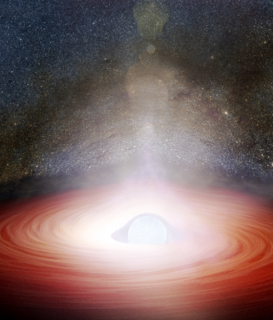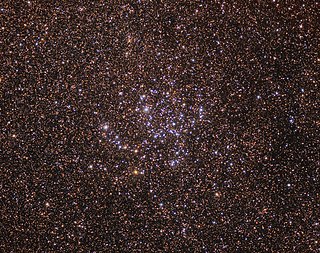
Alpha Centauri is a gravitationally bound system of the closest stars and exoplanets to Earth's Solar System at 4.37 light-years from the Sun. The name is Latinized from α Centauri, and abbreviated Alpha Cen or α Cen. It is a triple star system, consisting of the three stars: α Centauri A, α Centauri B, and the closest star α Centauri C.

A galaxy is a gravitationally bound system of stars, stellar remnants, interstellar gas, dust, and dark matter. The word is derived from the Greek galaxias (γαλαξίας), literally "milky", a reference to the Milky Way. Galaxies range in size from dwarfs with just a few hundred million stars to giants with one hundred trillion stars, each orbiting its galaxy's center of mass.

A neutron star is the collapsed core of a massive supergiant star, which had a total mass of between 10 and 25 solar masses, possibly more if the star was especially metal-rich. Except for black holes, and some hypothetical objects, neutron stars are the smallest and densest currently known class of stellar objects. Neutron stars have a radius on the order of 10 kilometres (6.2 mi) and a mass of about 1.4 solar masses. They result from the supernova explosion of a massive star, combined with gravitational collapse, that compresses the core past white dwarf star density to that of atomic nuclei.

A star is an astronomical object consisting of a luminous spheroid of plasma held together by its own gravity. The nearest star to Earth is the Sun. Many other stars are visible to the naked eye at night, but due to their immense distance from Earth they appear as fixed points of light in the sky. The most prominent stars are grouped into constellations and asterisms, and many of the brightest stars have proper names. Astronomers have assembled star catalogues that identify the known stars and provide standardized stellar designations. The observable universe contains an estimated 1022 to 1024 stars, but most are invisible to the naked eye from Earth, including all individual stars outside our galaxy, the Milky Way.

Sirius is the brightest star in the night sky. Its name is derived from the Greek word Σείριος. The star is designated α Canis Majoris, Latinized to Alpha Canis Majoris, and abbreviated Alpha CMa or α CMa. With a visual apparent magnitude of −1.46, Sirius is almost twice as bright as Canopus, the next brightest star. Sirius is a binary star consisting of a main-sequence star of spectral type A0 or A1, termed Sirius A, and a faint white dwarf companion of spectral type DA2, termed Sirius B. The distance between the two varies between 8.2 and 31.5 astronomical units as they orbit every 50 years.

In astronomy, stellar classification is the classification of stars based on their spectral characteristics. Electromagnetic radiation from the star is analyzed by splitting it with a prism or diffraction grating into a spectrum exhibiting the rainbow of colors interspersed with spectral lines. Each line indicates a particular chemical element or molecule, with the line strength indicating the abundance of that element. The strengths of the different spectral lines vary mainly due to the temperature of the photosphere, although in some cases there are true abundance differences. The spectral class of a star is a short code primarily summarizing the ionization state, giving an objective measure of the photosphere's temperature.

A binary star is a star system consisting of two stars orbiting around their common barycenter. Systems of two or more stars are called multiple star systems. These systems, especially when more distant, often appear to the unaided eye as a single point of light, and are then revealed as multiple by other means.
The Henry Draper Catalogue (HD) is an astronomical star catalogue published between 1918 and 1924, giving spectroscopic classifications for 225,300 stars; it was later expanded by the Henry Draper Extension (HDE), published between 1925 and 1936, which gave classifications for 46,850 more stars, and by the Henry Draper Extension Charts (HDEC), published from 1937 to 1949 in the form of charts, which gave classifications for 86,933 more stars. In all, 359,083 stars were classified as of August 2017.

A star system or stellar system is a small number of stars that orbit each other, bound by gravitational attraction. A large group of stars bound by gravitation is generally called a star cluster or galaxy, although, broadly speaking, they are also star systems. Star systems are not to be confused with planetary systems, which include planets and similar bodies.

Louis Burt Mayer was a Canadian-American film producer and co-founder of Metro-Goldwyn-Mayer studios (MGM) in 1924. Under Mayer's management, MGM became the film industry's most prestigious movie studio, accumulating the largest concentration of leading writers, directors, and stars in Hollywood.

Brittle stars, serpent stars, or ophiuroids are echinoderms in the class Ophiuroidea closely related to starfish. They crawl across the sea floor using their flexible arms for locomotion. The ophiuroids generally have five long, slender, whip-like arms which may reach up to 60 cm (24 in) in length on the largest specimens. From New Latin ophiurus, from Ancient Greek ὄφις + οὐρά.

A B-type main-sequence star is a main-sequence (hydrogen-burning) star of spectral type B and luminosity class V. These stars have from 2 to 16 times the mass of the Sun and surface temperatures between 10,000 and 30,000 K. B-type stars are extremely luminous and blue. Their spectra have neutral helium, which are most prominent at the B2 subclass, and moderate hydrogen lines. Examples include Regulus and Algol A.

Dancing with the Stars is an American dance competition television series that premiered on June 1, 2005, on ABC. It is the US version of the UK series Strictly Come Dancing, and one of several iterations of the Dancing with the Stars franchise. The show was first hosted by Tom Bergeron from its inception until 2019. Lisa Canning was co-host in the first season, Samantha Harris co-hosted seasons two through nine, Brooke Burke-Charvet in seasons ten through seventeen, and Erin Andrews from season eighteen through twenty-eight. The show was renewed for its twenty-ninth season which premiered on September 14, 2020 with the addition of new host Tyra Banks, replacing Bergeron.

Michael Bakari Jordan is an American actor and producer. He is known for his film roles as shooting victim Oscar Grant in the drama Fruitvale Station (2013), boxer Donnie Creed in Creed (2015), and Erik Killmonger in Black Panther (2018), all three of which were written and directed by Ryan Coogler. Jordan reprised the role of Creed in Creed II (2018), and Killmonger in What If...? (2021), and is set to star and make his directorial debut in Creed III (2022).

The Milky Way is the galaxy that includes the Solar System, with the name describing the galaxy's appearance from Earth: a hazy band of light seen in the night sky formed from stars that cannot be individually distinguished by the naked eye. The term Milky Way is a translation of the Latin via lactea, from the Greek γαλακτικός κύκλος, meaning "milky circle." From Earth, the Milky Way appears as a band because its disk-shaped structure is viewed from within. Galileo Galilei first resolved the band of light into individual stars with his telescope in 1610. Until the early 1920s, most astronomers thought that the Milky Way contained all the stars in the Universe. Following the 1920 Great Debate between the astronomers Harlow Shapley and Heber Curtis, observations by Edwin Hubble showed that the Milky Way is just one of many galaxies.

Yavarum Nalam is a 2009 Indian Tamil/Hindi-language psychological horror film written and directed by Vikram Kumar. The film stars Madhavan and Neetu Chandra in the lead roles. Produced by Suresh Balaje and George Pius, the film was simultaneously filmed and released in Hindi as 13B: Fear Has a New Address with a slightly different cast. It was also later dubbed into Telugu as 13-Padamoodu, while re-shot a few scenes with Ravi Babu. The film's soundtrack was composed by Shankar-Ehsaan-Loy, while Tubby-Parik provided the background score. Released on 6 March 2009, the film received highly positive reviews and became a blockbuster. Rediff called the film as one of the best films of 2009.
Ophiocanops fugiens is a living species in the brittle star family Ophiocanopidae. Though once considered to be the only one living species in this brittle star family, recent research has brought to light three specimens of Ophiocanops that differ substantially from O. fugiens. It has been regarded as the most primitive brittle star, close to Paleozoic forms, though other authors have disagreed with the view. Classification of O. fugiens is highly argued. Ophiocanops is usually placed in the order Oegophiurida or regarded as a genus incertae sedis or even given its own subclass Oegophiuridea. Some recent data suggest its relationship to the extant family Ophiomyxidae.

NGC 3114 is a sparse open cluster which is projected onto the outskirts of the Carina complex.

The Kardashian family, also referred to as the Kardashian–Jenner family, is an American family prominent in the fields of entertainment, reality TV, fashion design, and business. Founded by Robert Kardashian and Kris Jenner, it consists of their children Kourtney, Kim, Khloé, and Rob Kardashian, as well as their grandchildren. After Kris and Robert's divorce in 1991, Kris married Caitlyn Jenner, with whom she had two daughters: Kendall and Kylie Jenner. Notable extended relatives include Kendall and Kylie's half-siblings, Brandon and Brody Jenner.
















